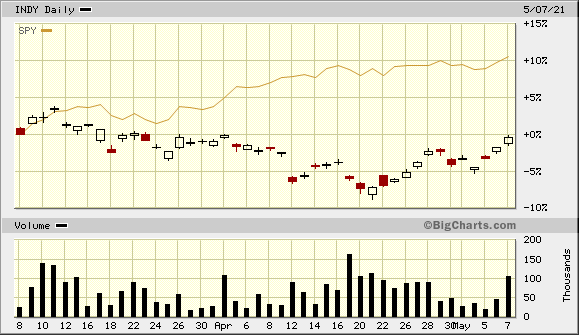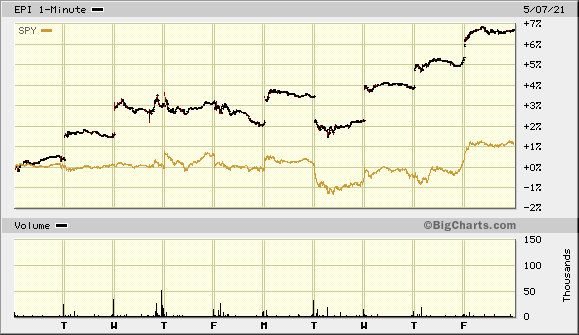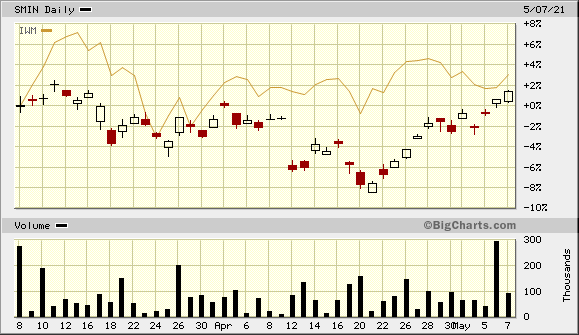Editor’s Note: This is a journalism article that merely expresses our personal opinions and features comments made on Social Media, Print & Television. It is not an investment article. It is NOT intended to provide any investment advice of any type whatsoever. No one should base any investing decisions or conclusions based on anything written in or inferred from this article. Macro Viewpoints & its affiliates expressly disclaim all liability in respect to actions taken based on any or all of the information in this article. Investing is a serious matter and all investment decisions should only be taken after a detailed discussion with your investment advisor and should be subject to your objectives, suitability requirements and risk tolerance.
Two weeks ago, we asked Indian Stock Market – Is It Time To Get In? We wrote about this possibility because of a market signal we saw on Thursday, April 22, 2021, a signal we ourselves described as “flimsy & weak“. Given that, we raised the obvious question and answered it on Sunday April 25:
- “So why are we even considering it? For one, it is just a feeling we have. A feeling that has been described in the “darkest before dawn” phrase. The other is the reality that relative to the US stock market, the Indian stock market has fallen by over 15% in about 6 weeks.”
Guess what? The “darkest before dawn” turned out to be right both absolutely & relative to the US stock market. Below is the two -week performance of the main US Exchange Traded Fund (ETF) and four Indian ETFs from the close on Friday, April 23, 2021 to this Friday May 7, 2021:
- SPY US (S&P 500) – Up 1.3%
- INDA (iShares MSCI India) – Up 5.5%
- INDY (iShares India 50) – Up 6%
- EPI (Wisdom Tree Earnings Fund) – Up 7.6%
- SMIN (iShares MSCI Small-Cap) – Up 7.3%
How does the 15% underperformance chart we used two weeks ago look now?
Better with the 15% underperformance reduced to just about 10% .
The parallel with US in 2020
Two weeks ago, we wrote about what we observed & experienced in March 2020 in US market. The parallel was a part of our case & it is working out at least so far. We reminded readers about the speech of President Trump from the Rose Garden of the White House on Friday, March 13, 2020. Then we reminded readers of our article in March 22, 2020 which described the positive market signal on Thursday, March 19, 2020.
As we wrote two weeks ago, we thought of PM Modi’s speech on Tuesday, April 20, 2021 as a timing trigger to start thinking positively. It was like what we felt in March 2020 after President Trump’s speech. Also, as we wrote two weeks ago, we saw a positive signal for the Indian market on Thursday, April 22, 2021, two days after Modi’s speech. That was our reason to ask whether Is It Time to Get In into the Indian stock market two weeks ago. And that question has been answered affirmatively as we pointed out above.
This week we saw another parallel. Last year, US Federal Reserve (Fed) Chairman Powell went on US National TV to assure the American people about the Fed’s commitment to add liquidity to US capital markets. And this past week, Indian Reserve Bank Governor Shakti-Kaanth Das went on Indian National TV, on Wednesday May 5, to announce a $6.7 Billion liquidity facility. Look what that speech did to Indian markets on Thursday & Friday (up 3%) in a two-week chart just for visual ease:
Indian Economy
As we all know, markets look forward & economic data is viewed backwards, meaning after the fact. Yes, we understand what RBI Governor announced on May 5 and what that might do for the Indian economy going forward. But the big question we had was how did the Indian economy behave in April, the first full-month of the Coronavirus spread & the market downturn that began around March 11, 2021?
We got the answer from a rational, soft spoken Anubhuti Sahay of Standard Chartered Bank in Mumbai via her appearance on Bloomberg TV on Thursday May 6.
In her discussion, Ms. Sahay pointed out surprising differences between this terrible 2nd CoronaVirus wave and the first wave last year:
- “ … a big difference is in the dent on economic activity; unlike the first wave which saw economic activity slow down, this time economic activity has been far more resilient … the dent is much lesser when compared to the first wave … “
As many know, 60% of India’s GDP is contributed by household consumption expenditure. Surely, that must have suffered given the horrific pictures we see in both US & Indian media? Guess what Anubhuti Sahay said?
- “… it was surprising to us that in the month of April despite a very very intense 2nd wave, consumption has proved pretty resilient; on the production side whether you look at PMIs, they were comfortably above 50; in the month of May, we are seeing some marginal contraction; whether you talk about fuel sales which is a good representative of both consumption as well as of production side of the story; but there is no significant drop in consumption or a significant increase in savings at this juncture which is a sharp contrast with what we saw last year; so far now consumption has proved resilient …. for the consumers at large, they have learnt how to deal with a pandemic & how to manage daily income & spending …”
Ms. Sahay also makes it clear that what she is seeing now may not last if India faces a 3rd wave that is as intense as this 2nd wave or if this 2nd wave goes on for a long time. But, again surprisingly, if this 2nd Wave does slowly gets reduced in its intensity and a 3rd wave is not as intense as this one has been, then Ms. Sahay feels that consumption may remain resilient.
With this in mind, look at the 2-month chart (that shows start of the 2nd wave decline around March 11) of leading small-cap ETFs in India (SMIN) and USA (IWM) both of the BlackRock iShares family of ETFs:
So the Indian Small-Cap ETF has made back almost all the decline it suffered relative to the US Small-Cap ETF. This is in sharp contrast to the 10% relative under-performance chart of large-cap INDY to large-cap SPY.
Indian Upper Class vs Lower Class
The above does support what we have felt for the past two weeks – that this 2nd CoronaVirus wave has hit the urban upper class more intensely than India’s rural & semi-urban lower class. The first wave in 2020 was just the reverse. So while the damage to economy & consumption was worse in the 1st wave, the media impact was much lower & relatively restrained.
This time, while the damage to broad Indian consumption is much less per Ms. Anubhuti Sahay, the physical impact on urban upper class is very intense. And that is why the outcry on TV & on Social Media is so intense & loud. The urban upper class, especially in Mumbai & Delhi, is well versed in making their outrage public & the media, both Indian & Global, find it easier & juicy to cover it.
This is in no way meant to suggest that the enormity of physical, family & economic pain inflicted on India’s urban class is not horrific. We know so many who have either suffered or know someone who has suffered. Their pain is real & terrible. It feels even worse because this class didn’t feel anything close to this in the first wave. Tragically, this 2nd wave hit well-to-do Mumbai & then Delhi like an infections tidal wave when they were totally unprepared for it.
This might explain the huge difference between what we all see on TV & print and the macro picture explained above by Ms. Anubhuti Sahay and supported by the Indian stock market, especially the Small Cap sector.
What’s next?
Based on what we hear from sources we believe to be excellent, the drive being undertaken now is broad, intense & committed. Several have assured us that the Oxygen crisis faced by urban hospitals will be almost over by May-end or early June. A massive vaccination drive is now in full swing as well. So we are told that the “crisis” in Mumbai is nearly over and even Delhi is stabilizing.
There is no doubt that all of India is now on a war footing against this second wave. And this effort has long term positive consequences especially in terms of a new private-public joint action. A robust supply chain infrastructure is being established on a war footing and it will only be upgraded & broadened in the next few years. This 2nd corona wave will end up delivering to India what the country has needed in refrigeration & transportation.
This second wave has been like what the disaster at Pearl Harbor was to America in 1941. But that disaster led America to a major restructuring of Naval Strategy & the Navy. What America implemented in the couple of years after 1941 is still operational in US Navy today. We feel strongly confident that what India is building now & what India will build in the next couple of years will show a huge payback in years to come.
And, as usual, the markets will see it before it is fully reflected in the Indian economy and way way before the rich west-servile chattering classes in India even deign to notice it.
Frankly, the biggest change we see in the last two weeks is a burst of confident anger in India and an increasing pride about how India is now handling this CoronaVirus wave. One example is the message we received on this past Friday:
Editor’s PS: We recommend watching the entire 7-8 minute discussion below by Ms. Anubhuti Sahay on BTV:
Mother’s Day – Allow us to wish all a loving & lovely Mother’s Day. Indians always think of their country of birth as Bhaarat-Maataa or Mother India. So on this Mother’s Day, we feel especially happy to bring a more positive & factual appraisal of India’s virus crisis than many in the global media are spreading. What better way to celebrate Mother’s Day in this crisis than the original Vande Mataram song composed during the dark days of British colonial rule?
Send your feedback to editor@macroviewpoints.com Or @MacroViewpoints on Twitter



